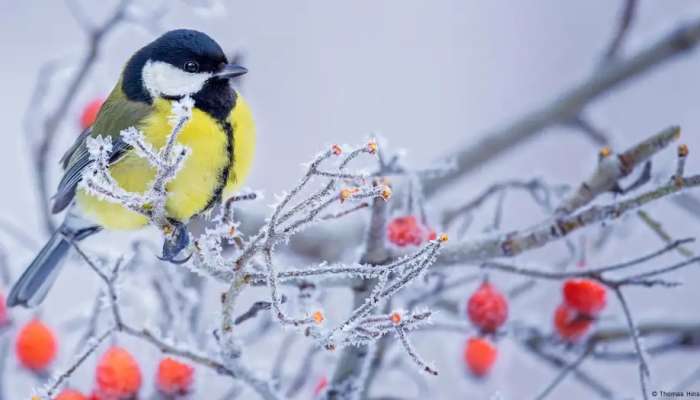
Frankfurt: Plants, birds, insects, mammals or amphibians have all developed strategies for the cold season.
Some sleep through it, some move to warmer regions, others find ways to stay snug.
But climate change is making winter milder, disrupting the cold weather routine of plants and animals. Some species are not very bothered by this, and others can even benefit.
But for many creatures, milder winters are a real danger.
How birds cope with winter
When it gets cold, numerous bird species head south where it's warmer and more food can be found.
Storks, nightingales and cuckoos travel thousands of kilometers. Others, the so-called short-distance migrants, only fly a little further south — from northern Europe to the Mediterranean, for example.
A sophisticated blood system ensures that bare bird legs remain cool, almost at zero degrees Celsius, explaining how ducks survive around icy water.
In order to maintain warmth, resident birds need sufficient food. As there are hardly any insects around in winter, many resort to eating nuts and seeds.
Others deliberately stockpile food: Eurasian jays bury it in the ground, for example, while tit species use crevices in the bark of trees as hiding places. Birds also find spiders or insect larvae in trees or in piles of leaves.
Mild winters not only cause problems for migratory birds
During warmer winters, some partial or short-distance migrants, such as cranes or starlings, chaffinches or robins, decide at shorter notice whether to migrate. Some fly limited distances, and those that do travel usually return earlier.
As temperatures rise, birds also mate and breed earlier in the year. This can be an advantage. The earlier the breeding season begins, the greater the chance of raising two or three broods.
But the longer breeding season is a problem when there are insufficient insects to feed the offspring. That said, if the first brood dies, the birds might breed again later.
Long-distance migrants can struggle to find nesting sites overrun by resident birds breeding early in the warmer winter. Predators that have birds on their menu are also active earlier in the milder weather.
Bird species that are particularly well-adapted to cold temperatures, including the rock ptarmigan or Nordic goose, are retreating northwards and to higher altitudes as temperatures rise. However, because these areas are geographically limited, their populations are dwindling.
How insects hibernate
Insects are cold-blooded animals, meaning they depend on the environment to regulate their body temperature. This is why some butterfly species such as the admiral or the lady butterfly migrate south in winter.
Meanwhile, bumblebees and beetles retreat underground to survive the cold, and mason bees spin themselves into a cocoon. Some insects hibernate as eggs, for example in dried plant remains, or as pupae. Others look for protective hibernation sites in attics, sheds, piles of leaves or dead wood, where they go into torpor to save energy.
However, if temperatures reach around 10 degrees Celsius (50 Fahrenheit) during a mild winter, many insects awaken from their torpor and use up energy. Additionally, little food is available for these creatures when flowers and shrubs are not yet in bloom.
To hibernate or go dormant?
Among mammals, a distinction is made between hibernation and dormancy.
True hibernators like bats, dormice, hamsters, hedgehogs and marmots drastically reduce their body temperature and all bodily functions during the winter months.
Hedgehogs, for example, breathe once or twice a minute instead of 40 to 50 times, and their heart beats five times a minute rather than 200. The body temperature also drops radically.
In hibernators, periods of rest alternate between short bursts of wakefulness during which the animals are active and sometimes defecate, urinate or change their sleeping place.
The fact that hedgehogs, for example, wake up during higher winter temperatures is not a problem for healthy animals.
It only becomes dangerous for hibernators when mild phases alternate too frequently with cold spells.
The fat reserves they have built up may no longer be sufficient to survive the whole winter. This is why hibernators should be disturbed as little as possible.
Animals like badgers, squirrels, raccoons and brown bears survive winter by going dormant, meaning they do not need to lower their body temperature but keep warm with their thick winter fur.
Dormant animals are frequently awake in winter and often change their sleeping position. Brown bears spend up to seven months in real sleep without defecating, urinating, eating or drinking.
Sudden cold snaps decimate amphibians
If the winter is very short or mild, sudden cold spells can threaten amphibians such as frogs, toads and newts, or reptiles like snakes and lizards.
As they are cold-blooded and cannot control their own body temperature, sudden extreme cold leaves migratory amphibians especially vulnerable. With nowhere to take cover to protect themselves from the cold, they can freeze to death.
What do mild winters do to the plant world?
Early bloomers such as hazel and alder, cornelian cherry and snowball are increasingly starting to bloom in January — two months before the Northern Hemisphere spring.
Spring flowers such as snowdrops, crocuses, primroses, violets and lesser celandine also start to bloom during mild winters.
This can mean that the blooming cycle no longer coincides with the emergence of pollinating insects. The result is that plants may have already faded, causing the food supply to become scarcer.
Trees, on the other hand, have a problem with late frost in mild winters.
Having developed their first leaf shoots too early, these die off during cold snaps. Though trees sprout again later after the frost, by then they have used up essential energy and are more susceptible to diseases and pests.
And if fruit tree flowers that have bloomed in the mild weather freeze during a late frost, no new buds emerge — meaning no fruit.